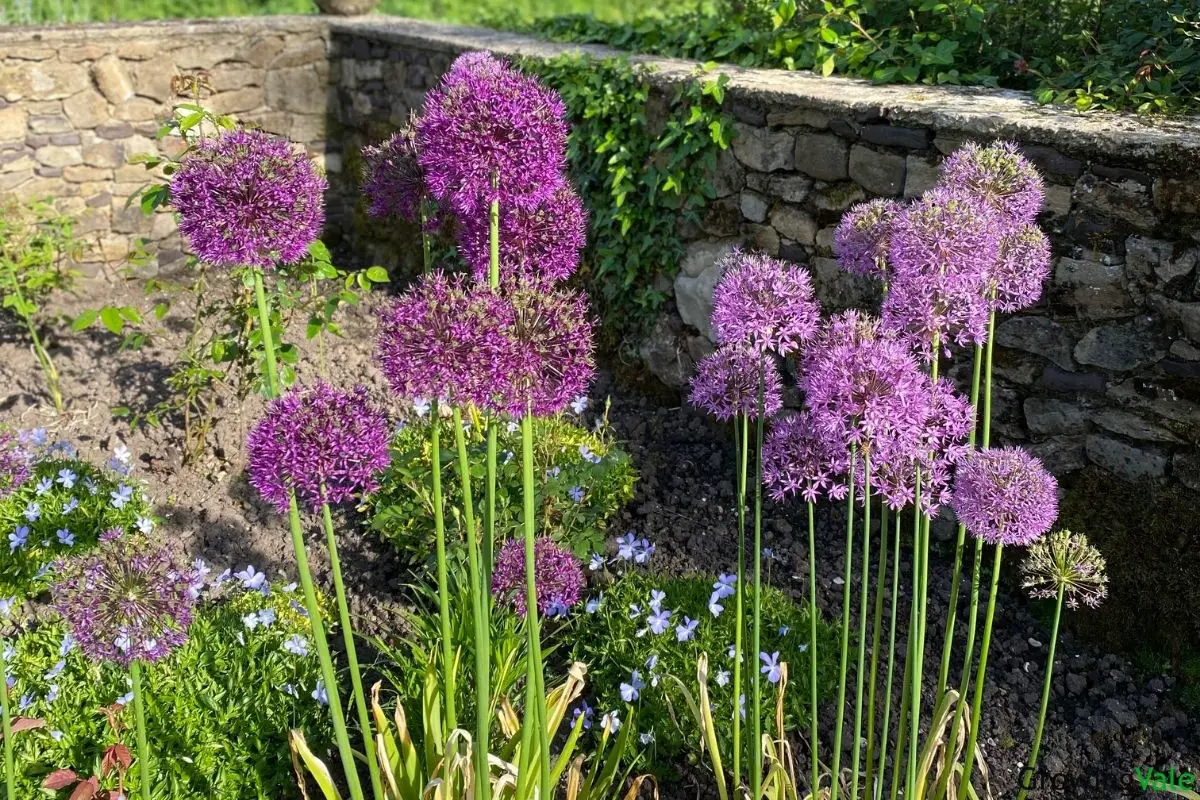The perfect addition to any garden, Alliums, commonly known as Ornamental Onions, are a bold and unusual plant. They mostly bloom from late spring to early summer (a few species will bloom in fall), and look right at home in cottage-style gardens or dotted throughout sunny borders. These flowers attract bees and butterflies, so they are also a great choice for a pollinator garden.
Most species are bulb-forming, however, a small number grow from rhizomes. This perennial plant is easy to propagate and can be grown in containers as well as garden beds.
History
The genus Allium contains approximately 700 species. Many are native to the northern hemisphere and can be found growing wild in mountainous regions or forests. Allium plants include ornamentals bred for landscapes, and perhaps some of our most important food crops – onions, garlic, and leeks.
The cultivation of these plants dates back thousands of years. References to Alliums in the Bible and the Koran highlight their importance not only as edible plants but also as medicinal herbs.
Allium flowers grow in clusters and are most recognizable by their round, pom-pom-shaped flower heads. However, they can also grow in other forms such as star-shaped, cup-shaped or, hang down. Allium plants range in size with some flower heads reaching as large as a volleyball. Colors include white, pink, yellow, purple, red, and blue.
Plant Facts
| Scientific name | Allium spp. |
| Common names | Ornamental Onion, Ornamental Allium |
| Genus | Allium |
| Family | Amaryllidaceae |
| Height | 1 ft. 0 in. – 4 ft. 0 in. |
| Width | 0 ft. 6 in. – 1 ft. 0 in. |
| USDA Plant Hardiness Zone | 3a, 3b, 4a, 4b, 5b, 5a, 6a, 6b, 7a, 7b, 8a, 8b, 9b, 9a |
| Origin | Worldwide except for The Tropics, Australia, and New Zealand |
| Flower colors | Pink, Purple, Red, White, Yellow, Blue |
| Plant/Flower special features | Pom-pom-shaped blooms |
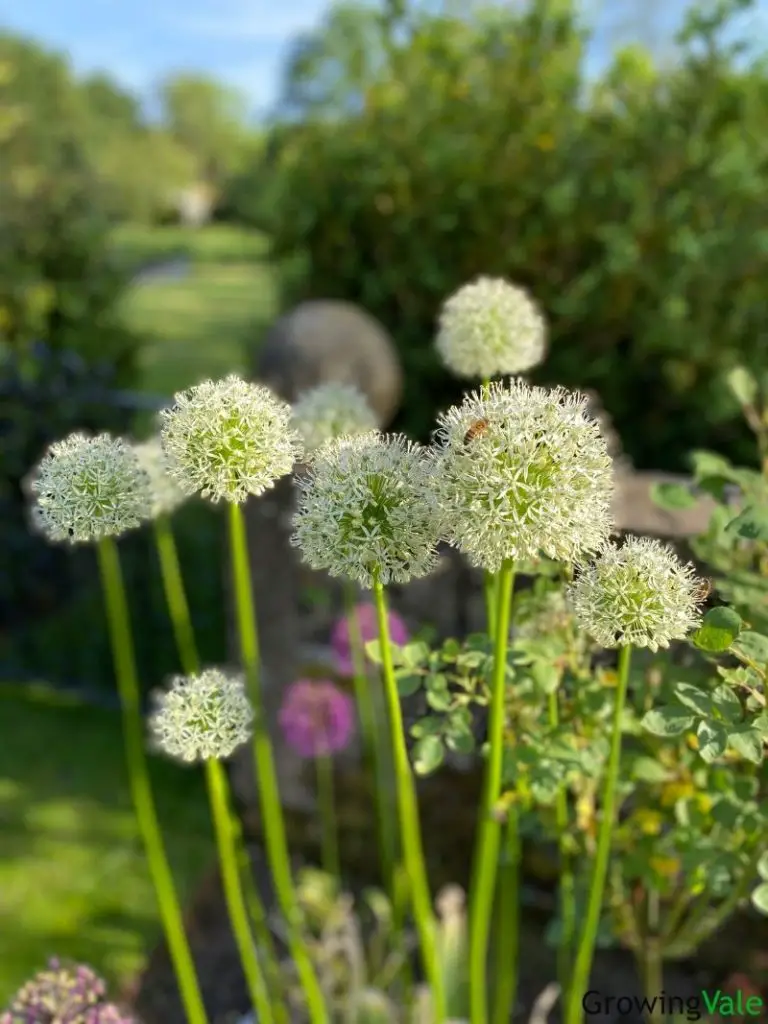
How to Plant Allium Bulbs
When is the best time to plant allium bulbs? Allium should be planted in early to mid-fall. When choosing where to plant the bulbs, whether directly in the garden or in a pot, it’s best to double-check the final height of the plant. Some species can grow up to 3-4 feet tall and obscure the view of other plants in the bed or container.
During flowering, the foliage dies down and can look unsightly. Place allium bulbs in a spot where surrounding plants can mask unsightly foliage while still showcasing blooms. Low-lying perennials such as hostas make a good choice.
Growing Alliums in a Bed
When choosing a site, Alliums require free-draining soil, sunshine, and shelter (flower stalks can easily be blown over by strong winds). Choose areas of the garden not regularly tended to, because bulbs can be damaged accidentally while digging.
Dig holes roughly four times as deep as the diameter of the bulb. For smaller Alliums, plant 3-4 inches apart, larger Alliums should be planted at least 8 inches apart.
Alliums grown in beds are hardy and do not need any extra care during the winter months.
Growing Alliums in a container
When choosing a container, ornamental onions prefer deeper pots. Use the same guidelines as bed planting for depth and space between bulbs.
Alliums grown in pots will need extra care over the winter months. Move the container to a sheltered spot – either next to a wall or in a greenhouse for overwintering.
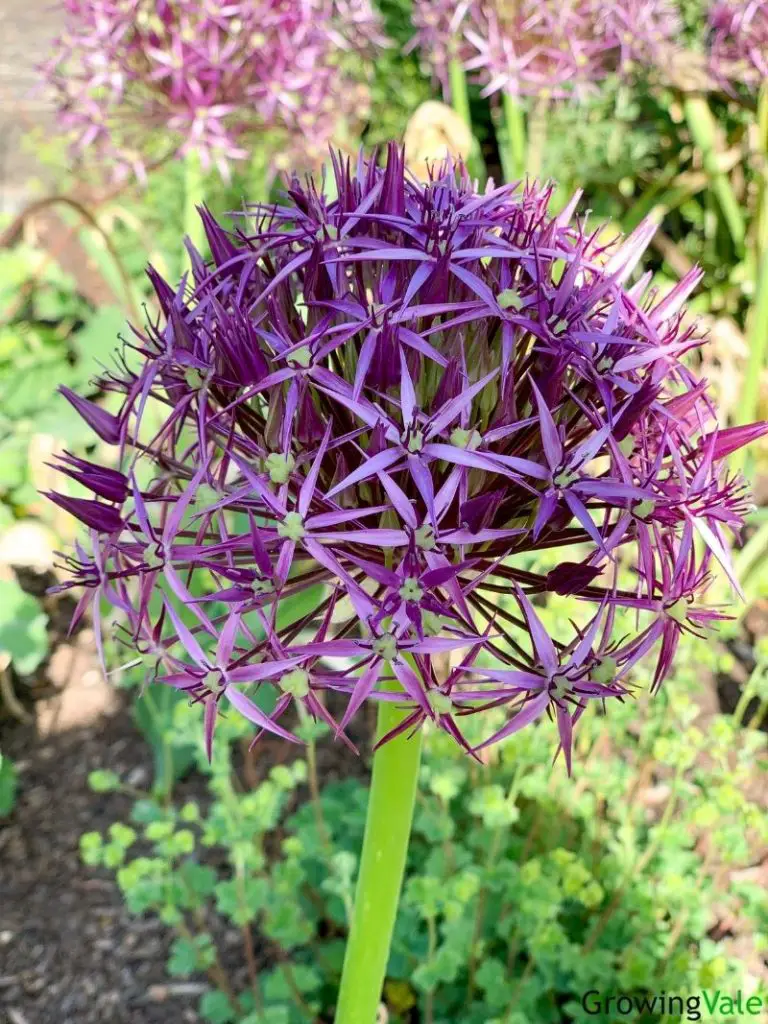
Care and Maintenance
Soil
Ornamental onions prefer well-drained soils as bulbs can rot if left in wet conditions for extended periods. These plants will not do well in wet-clay soil types. Under these conditions, it is recommended to either grow them in raised beds or to mix the soil thoroughly with organic matter and horticultural grit.
For plants grown in raised beds or containers, use peat-free multipurpose compost. Avoid freshly manured soil as these can be too nutrient-rich.
Water
These plants are drought-tolerant and those in the ground require little watering other than the rain. Allium plants grown in containers will require regular watering, however, care should be taken to ensure the soil does not become waterlogged as this will cause bulbs to rot.
Fertilizer
Allium flowers do not require regular feeding, however, a surface application of a balanced fertilizer is recommended in fall to feed growing root systems. If the soil quality is poor, an additional light fertilization can be done in spring as new growth is emerging. Alliums that grow from rhizomes require feeding in spring with a balanced fertilizer.
Sunlight
The best spot for most ornamental onions is basking in full sun, making them perfect for sunny borders. However, woodland species will prefer more shady sites.
Temperature and Humidity
Allium plants are native to regions that experience dry, hot, summers and cold winters. Most are hardy to USDA zones 4-8, with a few tolerating conditions on either side of this range. Like most temperate-zone bulbs, they require a cold period for dormancy to bloom.
Pest and diseases
Ornamental onions are prone to the same pests and diseases as their edible counterparts, such as downy mildew, onion white rot, and onion fly. Avoid planting ornamentals in areas previously planted with onion crops to limit these problems. Others pests to note are slugs, snails, and the allium leaf miner.
Pruning
Deadhead old, dried flowers at the base to prevent self-seeding and to neaten up the flower bed. This isn’t strictly necessary, and old flowers can be left if desired, as they still look attractive once dried.
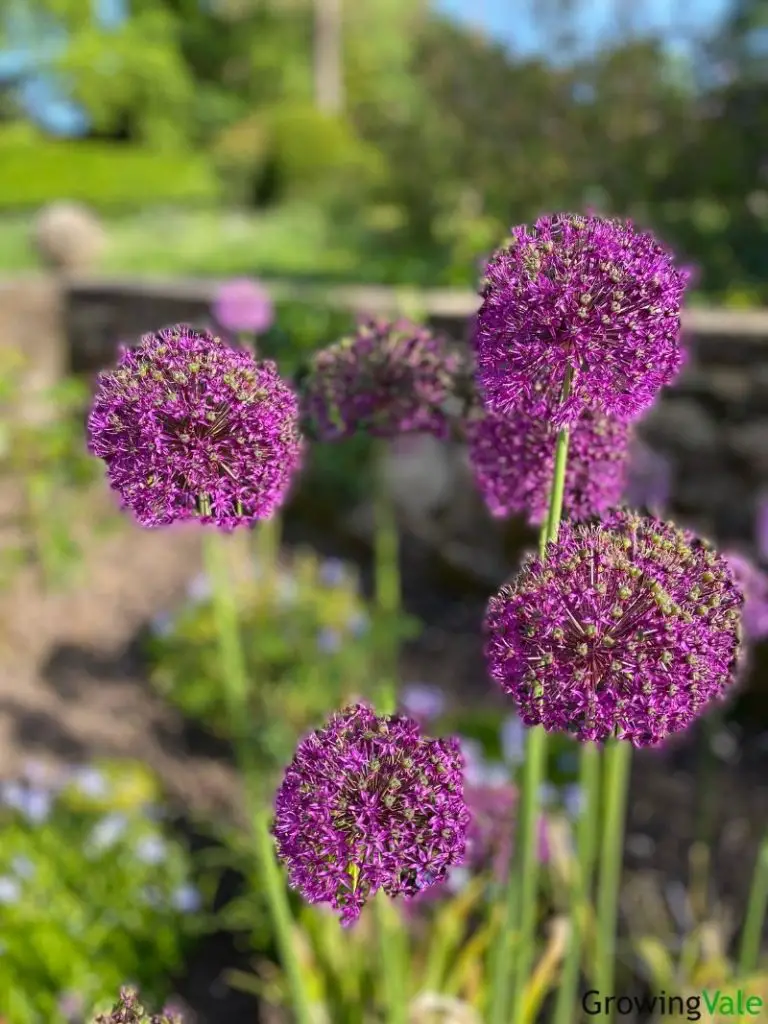
Propagation
Ornamental onions are easily propagated by a variety of methods depending on the species. The most common is from offsets (small clones produced by the parent plant). Other ways to propagate Alliums are from aerial bulbs (produced by some species), from seed, or by rhizome division.
Bulb Division
To propagate from offsets, wait until fall when flowering is over and foliage has died down, then gently lift out bulbs and carefully detach offsets. These can then be directly planted back into the ground in the desired spot or into containers. Most Alliums will need to be divided every 3-4 years to prevent overcrowding.
For aerial bulbs, carefully separate and detach bulbs from the parent flower head. Plant bulbs in moist, well-draining compost, 1 inch apart with a thin covering of soil. These plants will take several years to reach maturity.
Rhizome Division
Rhizome division should be done in spring. Dig up plants carefully and separate rhizomes using a sharp, clean blade. Plant rhizomes directly in their new area or in containers ensuring the shoots are pointing upwards.
Seeding
To grow Alliums from seed, collect or purchase seeds in fall, then sow into trays of gritty compost with a thin covering on top. Place trays outside in a shaded area. Plants should take 12 weeks to germinate but will take several years to reach maturity. If sowing seeds in fall isn’t possible, store seeds in the refrigerator and sow in spring.
It should be noted that plants grown from seed will be “hybrids” and may not resemble the parent plant in shape or color.
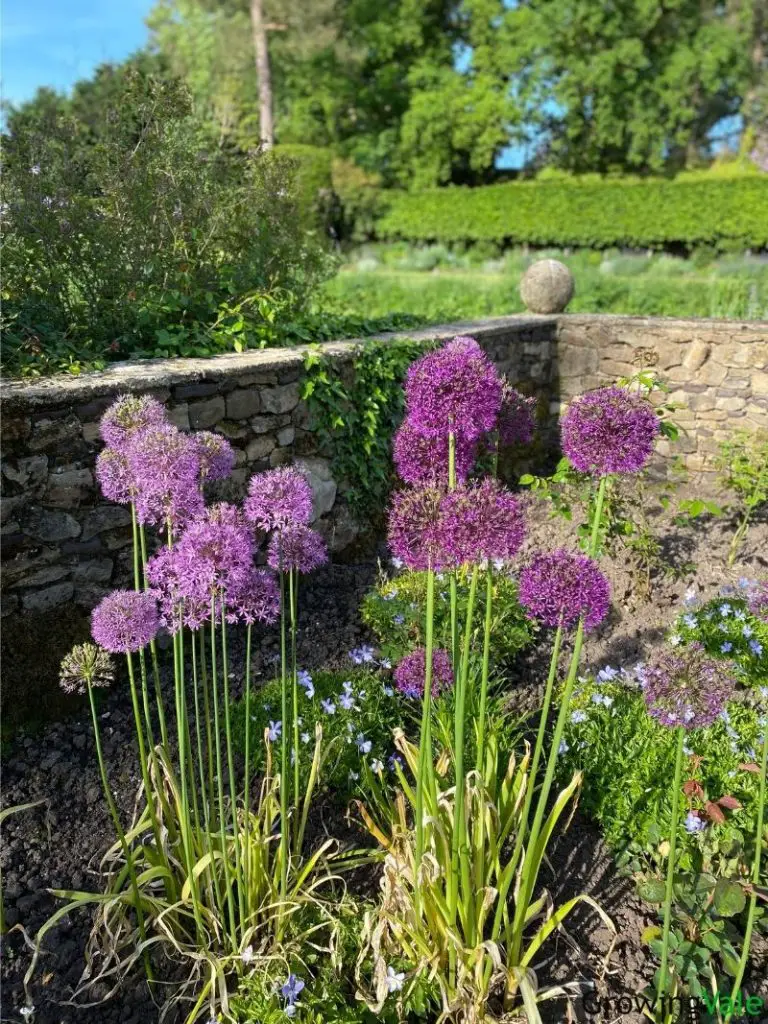
Uses of Allium Flower
The most well-known use of Alliums is as food crops. The Allium family contains garlic, onions, leeks, and chives. Ancient scrolls and artifacts depict the use of these plants in cooking in places such as Ancient Egypt, Ancient Iraq, Ancient China, and Medieval Europe. In modern times, most households worldwide contain onions and garlic, as they’re an integral part of many dishes.
Some ornamental Alliums are also considered edible. However, extreme care should be taken if attempting to eat these plants as they are also considered mildly toxic depending on quantity ingested, parts ingested, allergies, preparation, and age. Proper research and consultation with a medical professional are always recommended.
Aside from culinary uses, Allium flowers make great cut flowers for decoration. The dried flower stalks and heads can also be collected as they make great decorative pieces that will last a long time.
Conclusion
The genus Allium contains approximately 700 species, these include staple food crops such as onion, garlic, and leeks. Those cultivated for landscaping have beautiful and striking flowers which look great planted along sunny borders.
Flower heads are usually pom-pom-shaped clusters of smaller blooms that come in a variety of colors. Foliage dies down during flowering so planting alongside low-lying perennials such as hostas is recommended.
Alliums can be propagated in several ways and are relatively low maintenance plants making them great additions to any garden. Outside of the garden, aside from culinary purposes, flowers make great decorations whether freshly cut or dried.
See more: Types of allium flowers
*References
Reference list:
Carole Otteson. (2014). Ornamental Alliums
https://ahsgardening.org/wp-content/pdfs/OrnAlliums_TAG_SO14.pdf
Eric Block. (2010). Garlic and Other Alliums
N.C. Cooperative Extension, Allium,
https://plants.ces.ncsu.edu/plants/allium-giganteum/
”Close”

